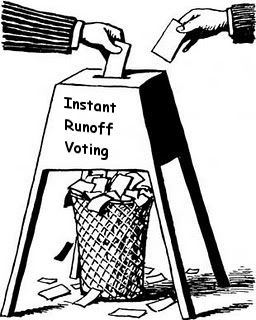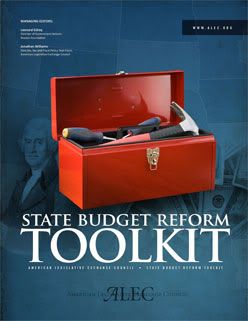 In November 2010, voters in North Carolina will be seeing something very different on their ballot when they vote for a candidate on the NC Court of Appeals...there will be 13 candidates running for that office, and voters will be instructed to rank all the candidates as 1st choice, 2nd choice, or 3rd choice.
In November 2010, voters in North Carolina will be seeing something very different on their ballot when they vote for a candidate on the NC Court of Appeals...there will be 13 candidates running for that office, and voters will be instructed to rank all the candidates as 1st choice, 2nd choice, or 3rd choice.
There is a way that you can defeat this effort to get you to vote for candidates you don't want, and Joyce McCloy has shared them with us:
Who should you rank 1st, 2nd or 3rd? With IRV, a candidate may win by getting the most 2nd choice votes. Keep that in mind as you head to the polls.
a) Rank only candidates you think will get enough votes to make the runoff
b) Voters should vote for party favorite and or their own personal favorite
Source: Protect North Carolina Elections: Stop Instant Runoff Voting (read the entire article)
If no candidate gets a majority, then the second and third choices will come into play...and there is a great possibility that the runoff will be decided without your input, you will have been very effectively denied the right to vote in the runoff...you will have been disenfranchised.
The current push to implement Instant Runoff Voting (nation-wide) was inspired by Fair Vote , a group whose ultimate goal is to convert the United States over to "proportional representation" a form of government used in many European countries. IRV is being touted as a way to boost third parties, reduce or eliminate the "spoiler effect", save money by avoiding runoff elections, increase turnout and decrease negative campaigning.
Another thing to remember is to complain about the IRV ballot to the people running the polls. If enough people complain about this all day long, then IRV may not be seen in a favorable light by poll workers and the various elections board across the state will view IRV as more trouble than it is worth. If you are so inclined, it might not be a bad idea to call the county elections board and complain about IRV as well.
Read more about why Instant Runoff Voting should be opposed at Instant Runoff Voting.
I am appending a text outline of the comments made by Joyce McCloy, the Director of the NC Verified Voter Coalition to the NC State Board of Elections below:
Outline of comments:
1. There is no software to tabulate IRV that meets the standards of our state law.
In guidelines for IRV pilots set by the State Board of Elections in January 15, 2009, the State Board of Elections proposed to use an uncertified method of vote tabulation with DRE machines that allows for an “electronic sort” using uncertified software that requires five pages of over 100 single spaced instructions. Experts warn that this spreadsheet tallying method is error prone, lacks an audit trail, and is not good enough for elections. See Standards for IRV Pilots -Approved by the North Carolina State Board of Elections on January 15, 2009
http://www.ncvoter.net/downloads/NCSBoE_IRV_Approved_1-15-2009 The voting vendor warns that IRV is not an approved function of our voting systems and has not been federally tested or certified as required by state law.http://www.ncvoter.net/downloads/PrintElectLetterAugust31_2010_not_legal
To comply with existing state law, IRV must be counted manually until IRV software and its accompanying algorithm is federally approved. This is workable with optical scan ballots, but in order to count the touch-screen paper trails, the vendor should be made to modify the software to print a ballot summary. Touch-screens currently print all selections made by voters, but not a final summary. While a simple contest can be recounted on the touch-screen paper trail, an IRV contest would be more laborious. For a simpler process, touch-screen counties could borrow or purchase optical scan machines for IRV elections.
2. IRV ballots cast on election day must be counted where they are cast just as “regular” ballots are counted as per § 163-182.2.
Initial counting of official ballots. In Cary, NC - the 2nd and 3rd choice votes cast for the "instant runoff" were not counted on election night. Instead, they were carried away from where they were cast and then counted at a later date. This differs from the treatment of absentee ballots and early voted ballots might be tabulated at the central office, these are “retrievable ballots”, not cast on election day. All votes cast at the polls on election day, including IRV ballots, are to be counted at the polls on election night once the polls close. The solution is to count all votes, 1st, 2nd and 3rd on site using the “Australian” method.
3. State law requires election night reporting for voters' second and third choices.
Law requires reporting of votes on election night. IRV ballots are not retrievable and cannot be reported at another date.
4. All votes must be counted. In free, fair and open elections, all votes are recorded and counted.
This means counting all votes, whether 1st, 2nd or 3rd choices. To do otherwise violates a core principle of democracy and tells voters that their choices and votes do not matter. Candidates, voters and officials want to know the breakdown of the votes. Votes must be counted for transparency sake. In the 2007 Pilot program, only partial data was reported for the District B contest where voters’ second and third choices were ultimately counted. In Cary’s other IRV contests for City Council, only some, not all of 2nd or 3rd place data was recorded or reported. In Hendersonville, the IRV votes were never counted or reported.
5. Provisional ballots must be counted before advancing to the 2nd round.
In the 2007 IRV pilot, Provisional ballots were not counted until after the 2nd and 3rd choices were counted, and supposedly "added" back in. Since IRV is not "additive", it is not clear how these votes could possibly be added back in without doing a complete recount.
6. Absentee ballots must be counted before advancing to the 2nd or 3rd round.
It is not clear when the absentee ballots were counted, so the question is - were they counted with the first, second and third rounds? They must be counted with the first round of voting before going to the next.
7. Canvassing of all first round votes, absentee and provisional ballots must be done before counting a second round of ballots.
This has to be done to get an accurate vote count.
8. Audit protocols will have to be developed in coordination with the state appointed statistician and according to current state laws.
Each round of voting must be proven correct if the subsequent round is to trusted. Audits and recounts must be publicly announced and observed, and notice must be given in time for the public to attend.
9. Voter education is expensive, must be repeated, and is not necessarily effective.
The results of Cary NC’s 2008 bi-annual citizen survey indicate that 22.0% did not understand IRV at all.
10. Overvote protection lacking.
North Carolina state law and the Federal Law, Help America Vote Act requires that voters be notified of over votes. NC’s voting machines are unable to notify the voters if they have “overvoted” in the IRV contests - if voters rank the same candidate more than once. The Help America Vote act defines overvotes: “In every election, some voters make more choices than are permitted in a contest, which creates what are called overvotes.”http://www.eac.gov/program-areas/research-resources-and-reports/copy_of_docs/eds-2006/overvotes-and-undervotes.pdf/attachment_download/file
With IRV, voters are not permitted to vote for the same candidate more than once in a given contest. To do so, renders their 2nd and 3rd choices invalid.
11. “Instant runoff voting” should be renamed “Ranked Choice Voting”.
Instant runoff incorrectly infers that the method provides the same results as a runoff election and does so instantly. It can take days or weeks to get the results of an IRV election.
12. IRV does not guarantee a majority winner.
The “instant runoff” contest in Cary, District B City Council in October 2007 was decided with less than a majority of votes.
13. IRV is a difficult way to provide the same results as plurality elections.
The fact is that most often, “Instant runoff voting” historically provides the same result as a plurality election, only with more effort.
14. Instant runoff voting is non-monotonic.
In other words, you can hurt your preferred candidate by voting for him or her.
15. Exit polls, should be conducted by election officials or impartial groups -not advocates, in order to preserve the appearance of objectivity in the results.
Exit polls should be carefully crafted to avoid being push polls. Pierce Co Washington mailed surveys to 91,000 voters, to be completed in the privacy of their homes.
This letter, along with my comments and recommendations set forth in the documents referenced above, and expanded upon in following pages, is my testimony.
The full report at this link:http://www.ncvoter.net/downloads/NC_Comments_on_IRV_and_2010_Judicial_Elections.pdf
Regards;
Joyce McCloy, Director
NC Coalition for Verified Voting
212 Evergreen Drive, Winston Salem, NC 27106






























0 comments :
Post a Comment